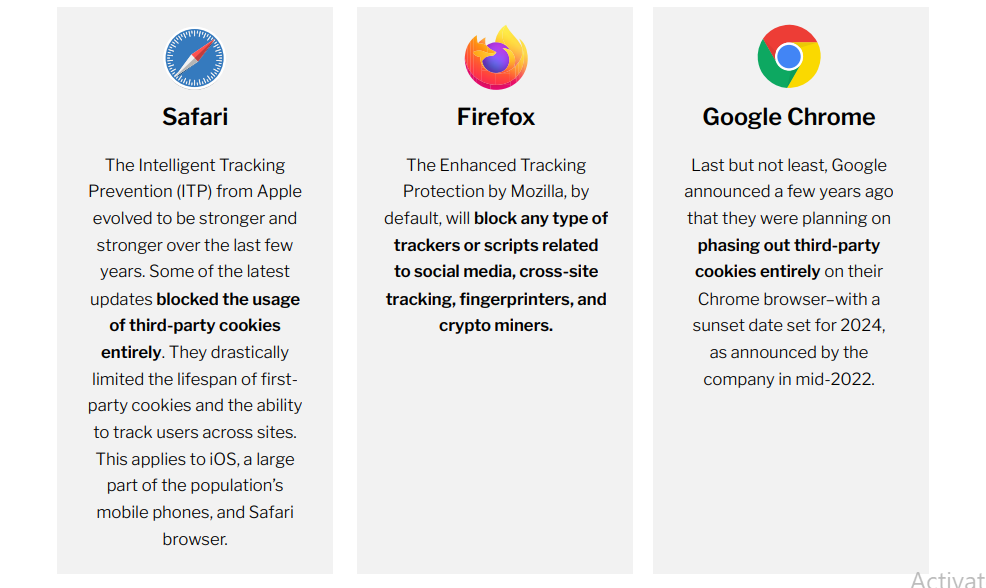Take Control of Your Data and Optimize The Customer Journey Guide | Vaimo
Customer Service
In the digital era, the realm of customer data management is undergoing significant transformations. As personal online identifiers, particularly third-party cookies, face increasing restrictions, businesses must recalibrate their strategies to meet changing realities.
Major browsers like Safari, Firefox, and Chrome have already embarked on this trajectory, implementing stringent tracking prevention measures. These shifts have profound implications for businesses, necessitating a reevaluation of their data management and customer engagement approaches.
The Changing Terrain of Customer Data Management
Third-party cookies, once the cornerstone of online tracking and ad targeting, are gradually becoming obsolete. Safari’s Intelligent Tracking Prevention (ITP) has progressively curtailed third-party cookie functionality. Firefox’s Enhanced Tracking Protection goes even further, blocking a range of trackers, from social media integrations to cross-site tracking tools.
Notably, Google Chrome, a dominant player with a significant market share, has announced its intention to phase out third-party cookies by 2024. These measures collectively underscore a seismic shift, affecting a vast majority of internet interactions and signaling the end of an era dominated by third-party data.
Implications for Businesses
The implications of these changes reverberate across various facets of business operations:
- E-commerce: Personalization has been pivotal in tailoring shopping experiences. Without it, product recommendations become generic, potentially dampening conversion rates. Businesses must innovate to ensure relevance in product suggestions. When e-commerce businesses make their clientele feel that their personal preferences and experiences are being factored into the equation, it leads to better interaction, and eventually higher sales figures and conversions.
- Email Marketing: Personalized emails, addressing recipients by their names or recommending products based on past behaviors, have higher engagement rates. How is this done? For instance, if you own a cosmetics brand and your customer has bought a toner prior, you can send them an email that acknowledges the fact and recommends other useful products that go well with their prior purchase. Another way to go with it is by offering discount coupons related to their previous buy with your business. The absence of such personalization could lead to diminished open and click-through rates, impacting campaign effectiveness.
- Content Customization: Media outlets leverage personalization to curate content based on user preferences. A lack of this customization may reduce user engagement, jeopardizing ad revenues and overall user experience.
- Advertising: Personalized ads, grounded in user interests and behaviors, tend to be more effective. Ad personalization could suffer without third-party cookies, leading to reduced engagement and potentially undermining advertising ROI.
- Customer Service: Personalized customer experiences, underpinned by data-driven insights, foster loyalty. Without such personalization, customer interactions may feel impersonal, eroding trust and loyalty. Bespoke client experiences can be achieved by using various tools that are designed to make journey orchestration relevant and efficient, actively gathering customer data and seeking feedback, and the like.
- User Experience: Personalization enhances the overall user experience, making interactions more intuitive and engaging. This can be achieved by being mindful of changing consumer tastes and experiences, meeting set expectations, and so on A generic user experience could elevate bounce rates, signaling dissatisfaction among users.
Rising Customer Expectations
Experts believe that the buyers of today are vastly different from the customers of way back then. The modern consumer is discerning, with heightened expectations for personalized experiences. According to a McKinsey study, 71% of consumers anticipate personalized interactions, and 76% are more likely to engage with brands offering such customization. As digital channels proliferate, businesses face the dual challenge of meeting these expectations and navigating an increasingly complex data landscape. It’s understandable for a business like yours to be at a loss when it comes to such seismic changes and movements in the industry. Luckily, the points below will aid entrepreneurs like you to successfully navigate the vast and uncertain waters of the modern-day business game. Read on.
Strategic Imperatives for Businesses
Given these challenges, businesses must adopt a strategic approach to data management:
- Long-term Vision: While short-term fixes might offer immediate relief, businesses must devise a long-term roadmap. Aligning data strategies with overarching business objectives ensures sustained relevance and growth.
- Unified Data Approach: Fragmented data silos inhibit effective personalization. Businesses should consolidate data sources, fostering a unified view of customers and enabling more nuanced engagement strategies.
- Transparency and Trust: With data privacy concerns on the rise, transparency emerges as a cornerstone of customer trust. Businesses must clearly articulate data usage policies, empowering consumers with control over their data.
- Investment in Modern Infrastructure: Legacy systems, ill-equipped to handle contemporary data challenges, are a hindrance. Investing in modern data architectures, equipped for real-time processing and analytics, is imperative.
- Embrace Customer Data Platforms (CDPs): CDPs offer a centralized solution for customer data management. By aggregating data from disparate sources, CDPs facilitate more effective personalization, ensuring compliance with data privacy regulations.
Final Word
The evolving data landscape presents both challenges and opportunities for businesses. While the phasing out of third-party cookies poses challenges to traditional data-driven strategies, it also catalyzes innovation, driving businesses toward more robust, customer-centric approaches.
Embracing modern tools like CDPs, prioritizing transparency, and fostering a culture of data-driven decision-making will be pivotal in navigating this transformative phase. As the adage goes, change is the only constant; businesses poised to adapt will not only survive but thrive in this dynamic digital ecosystem.
Ready to elevate your data strategy? Unlock the future of customer data management! Download our comprehensive guide now and stay ahead in the digital era.
The Table of Contents of “Take Control of Your Data and Optimize The Customer Journey” Guide:
- Harnessing CDPs for centralized customer data and cross-channel journey orchestration
- How we got here
- Increasing data privacy regulations
- The shift to first-party data
- Increasing demand for relevant customer experiences
- 5 Tips to Get Started
- Customer Data Platform
- What’s next?
- Take your data maturity to the next level!
- About the authors
- References
- Appendix
Number of Pages:
- 25 pages
Pricing:
- Free
Warning: Undefined array key "sidebar_ads" in /home/dmc/public_html/wp-content/themes/DMC/functions/helpers.php on line 824








